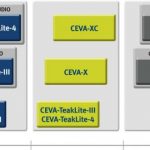Processor and GPU cores usually get the limelight, driven by the ARM and Imagination machines occupying the center square of most SoC designs. CEVA has quietly been assembling DSP IP in most of the squares around the edge, and may have just reached critical mass for wearables and IoT devices.… Read More
Tag: ceva
Always-on and the new wearable core
Recently, I mentioned smartphone SoCs consume one, maybe two orders of magnitude too much power for broader use in wearables. However, that is only when they are “on”. To save power and stretch battery life, smartphones spend a lot of time napping – display off, sitting still with MEMS sensors powered down, waiting for an incoming… Read More
Intel is Still Missing Mobile!
Paul McLellan was on assignment in Hong Kong last week so I attended the Linley Mobile Conference and was not surprised Intel did not present. During the networking sessions I asked more than a dozen people why and the answers were pretty focused on “Intel still does not play well with others” and “Intel’s current mobile offerings… Read More
More things on the DSP frontier at MWC14
With a well-chronicled share inside cellular baseband interfaces for mobile devices, one might think that is the entire CEVA story, especially going into Mobile World Congress 2014 this week. MWC is still a phone show, but is becoming more and more about the Internet of Things and wearables, and CEVA and its ecosystem are showing… Read More
What does a 52% increase in DSP IP core licensing means?
The future market performance for an IP vendor licensing an IP based on a model with upfront fee plus royalties can be easily and safely evaluated if you look at the first part of revenue: upfront fee. Even if the royalty part is declining, exhibiting a 52% increase (Q4 2013 to Q4 2012) in upfront licensing fee is a promise that the future… Read More
DSPs converging on software defined everything
In our fascination where architecture meets the ideas of Fourier, Nyquist, Reed, Shannon, and others, we almost missed the shift – most digital signal processing isn’t happening on a big piece of silicon called a DSP anymore.
It didn’t start out that way. General purpose CPUs, which can do almost anything given enough code, time,… Read More
OpenVX Bring Power-efficient Vision Acceleration to Mobile
OpenVX is the next open source sample specification to be launched by Khronos group, a consortium building a family of interoperating APIs for portable and power efficient vision processing. If you take a look at the OpenVX participant list, you can check that the major chip makers: Broadcom, Qualcomm, TI, Intel, Nvidia, Renesas,… Read More
EDA and Semi IP Stocks in 2013: MENT, ARMH, CDN, SNPS, ANSS, CEVA, IMG.L
2013 was an up year for the stock markets as both the DJIA and the tech-heavy NASDAQ showed significant growth, so how did EDA and Semi IP companies do in the past 12 months? A quick stock plot from Yahoo Finance shows us that only two of the seven companies beat the NASDAQ: ARMH, MENT.… Read More
Why CEVA Is My Favorite Semiconductor IP Stock For 2014
As a full time financial writer/investor, I am always on the lookout for compelling risk/reward opportunities, particularly in small-cap tech. While the world of large-cap tech is generally well understood by the investment/analyst community, smaller cap names are usually under-followed and often misunderstood. One such… Read More
A Brief History of DSP…Not By Any of Us
I came across an interesting article by Will Strauss which is pretty much the history of DSP in communication chips. Having lived through the early part of the history while I was at VLSI Technology I found it especially interesting.
At VSLI, our first GSM (2G, i.e. digital not analog air interface) was a 5-chip chipset. The DSP functionality… Read More





